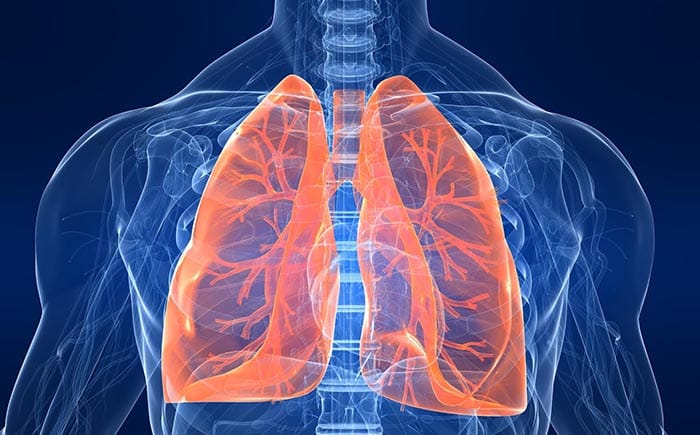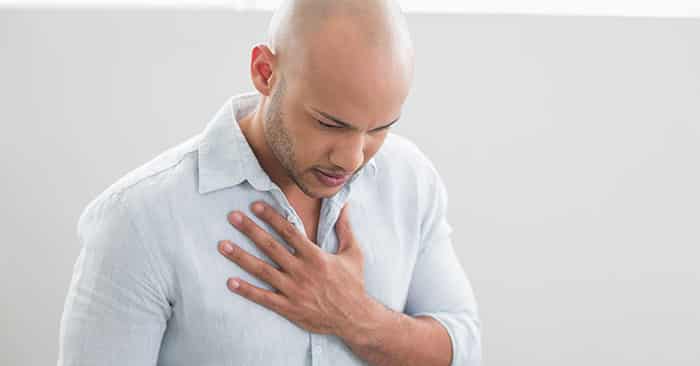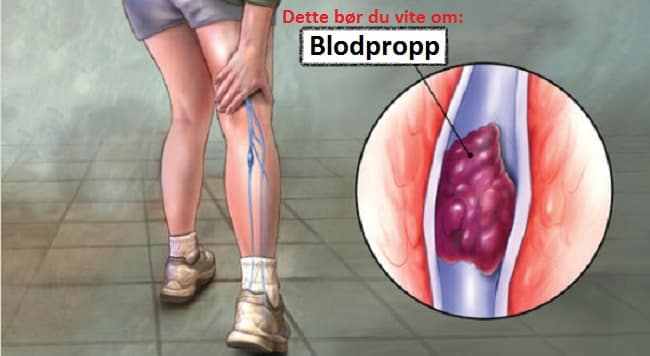
Pain in the Lungs (Lung Pain) | Cause, diagnosis, symptoms and treatment
Pain in the lungs? Here you can learn more about pain in the lungs, as well as the associated symptoms, cause and various diagnoses of lung pain. Lung pain and lung disease should always be taken seriously. Follow and like us too Our Facebook page for free, daily health updates.
The lungs are two organs located in the chest cavity on either side of the sternum. They are responsible for taking in air and oxygen - which are then distributed to the body through the bloodstream. Naturally, good function in the lungs is vital, so symptoms and pain in the area should always be examined by a doctor. Remember that it is better to contact the doctor once too much than once too little.
Pleuritis (pneumonia) is one of the most common causes of lung pain - in addition to pain from biomechanical dysfunctions in the thoracic spine and rib attachments (muscle pain and rib lock). It is important to mention that the lungs do not have any special pain receptors - so often the pain you experience comes from the surrounding areas; for example, the pleura or rib cage.
Are you wondering something or do you want more of such professional refills? Follow us on our Facebook page «Vondt.net - We relieve your pain»Or Our Youtube channel (opens in new link) for daily good advice and useful health information.
Cause and diagnosis: Why did I hurt my lungs?

Some of the most common causes of lung pain are the following diagnoses:
- Asthma
- Blood clot in the lung
- hyperventilation
- Collapsed lung (pneumothorax)
- Pneumonia
- Lung cancer
- Fluoride fluid (fluid retention in the lungs)
- Pleuritis (pneumonia)
- Rib locking or intercostal myalgia (muscle pain)
Asthma
If you have asthma, this can cause the immune system to cause swelling and inflammation of the airways - if they react to irritations. Such an immune reaction can lead to sore airways and pain in the chest, as well as the lungs. You can often experience pain in the chest and lungs after an asthma attack. This is because you cough deeply, breathe heavily and generally irritate the airways.
Blood clot in the lungs
A blood clot in the lungs can be fatal. It can cause extensive damage to the lungs due to it stopping the blood supply and their access to oxygen. As is known, such blockages can be fatal, as the lack of oxygen supply leads to cell death in the affected areas. Up to one third of those with blood clots in the lungs die if it is not detected in time.
Blood clots in the lungs can form due to a number of different causes. Deep vein thrombosis is often the precursor to a blood clot in the lungs - and is therefore due to blood clots in the deep veins (for example in the groin or lower leg) loosening and getting stuck in the lungs. Symptoms of blood clots in the lungs may include pain in the chest and lungs, shortness of breath, heart symptoms, problems with breathing, weak pulse and lethargy / fainting.
Collapsed lung (pneumothorax)
A pneumothorax is caused by abnormal collection of air between the lung wall and the inner chest wall. Increased pressure within this region may cause a collapsed lung on the involved side. The condition can occur due to a chest injury and lung disease (for example COPD or cystic fibrosis).
Pneumonia
An inflammation of the left or right side may be caused by viruses, bacteria or fungi. It is worth mentioning that the most common cause of pneumonia is bacteria. In the case of pneumonia, the small air sacs (alveoli) are filled inside the lungs with inflammatory reactions that make it difficult to breathe, and can cause local pain in the chest and lungs.
Lung cancer
Cancer of one or both lungs can cause chest pain. Lung cancer is uncontrolled cell division in the lung tissue that expands and spreads. Lung cancer can spread to the lymph nodes, the liver, the legs, the brain and the adrenaline glands.
Pleuritis (pleurisy) and pleural fluid
Pleuritis involves inflammation of the pleura. These membranes are located on the outside of the lungs and inside the inner chest wall. Such inflammation can be caused by viruses or bacteria and normally causes increased fluid in an area with limited space - such an accumulation of fluid in this area is called pleural fluid. Pneumonia can occur due to infections, tuberculosis, heart defects, cancer, blood clots and connective tissue diseases.
Symptoms of pleurisy are chest pain and lungs that are exacerbated by breathing, difficulty breathing, shortness of breath, and local pressure relief. Occasionally, the pain may also radiate backward toward the back or upward toward the shoulder of the affected side.
Rib locking and intercostal myalgia (muscle pain in the ribs)
Biomechanical dysfunctions are one of the most common causes of pain referred to the chest and lungs. In fact, it is muscles and joints that are often behind such pain in our modern age with a lot of static positions in everyday life and high stress levels.
The ribs attach to the thoracic spine - ie the spine that runs from the neck transition and down to the thoracic lumbar transition (where the thoracic spine meets the lower back) - and naturally dysfunction can occur here as in all other joints. With hypomobility in the thoracic spine and rib attachments, this can lead to severe muscle pain in the ribs and referred pain towards the chest and lungs - especially rhomboideus and iliocostalis thoracis are often involved in such pain.
The treatment consists of joint mobilization and muscular work - as performed by a modern chiropractor.
Symptoms of pain in the lungs

Having pain in the lungs and nearby areas can be both daunting and quite painful. The pain and symptoms will vary depending on the cause and the diagnosis itself - but there are certain variations associated with the different diagnoses that help us distinguish between the different causes.
Symptoms of asthma
Common symptoms of asthma include narrowing of the airways, inflammation of the bronchioles and fluid retention.
Common symptoms of asthma include:
- Hosting - especially at night
- Shortness of breath
- Impaired lung function (measured by lung tests and spirometry)
- Pressing pain and tightness in the chest
- wheezing
Symptoms of blood clots in the lungs
The symptoms that occur with a blood clot in the lungs depend on both the size of the blood clot and where it settles. The most characteristic symptom of such a blood clot is breathing problems and shortness of breath - the symptom can occur gradually or acutely.
Other symptoms of pulmonary embolism include:
- Anxiety
- fainting
- Chest pain radiating to the arms, jaw, neck and shoulder
- Coughing up blood
- Irregular heartbeat
- Moisture in the skin
- Lightness
- restlessness
- Weak pulse
If you experience symptoms that may indicate a blood clot, contact your doctor immediately.
Symptoms of collapsed lung (pneumothorax)
Surprisingly to many, but a collapsed lung can be almost asymptomatic at first and can often be misinterpreted as other diagnoses. However, it can also cause severe pain, as well as the aforementioned symptoms:
- Fainting (and possibly coma in the worst cases)
- Chest pain that is worst on one side
- Increased heartbeat
- Skin color changes (lips or skin may turn bluish)
- Frequent breathing pattern
- Sharp pains in breathing
- Dizziness
- Pressure in the chest that gets progressively worse and worse
- Difficulty breathing (shortness of breath)
The above symptoms are of such a nature that all persons experiencing them should contact a physician immediately.
Symptoms of lung cancer
The vast majority of cases of lung cancer are not symptomatic should they spread to other parts of the body (metastasis), but certain cases of lung cancer can cause early symptoms that can be detected at an early stage - and thus receive the most effective treatment.
The most common symptoms of lung cancer are:
- Chest pain that is worse by deep breathing, hosting and when you laugh
- Hes voice
- Coughing up blood
- Infections such as bronchitis and pneumonia that become chronic
- Shortness of breath
- Chronic cough that does not go away or gets worse
- Lack of appetite
- Discolored saliva
- Accidental weight loss
- Exhaustion
- Difficulty with breathing
We want to emphasize the importance of keeping an eye on one's own health and taking care of oneself with regular exercise, avoiding smoking (80-90% of lung cancer is directly related to smoking) and a good diet.
Also read: - How to Eat for Healthier Lungs
Symptoms of pleuritis (peritonitis)
The most characteristic symptom of pneumonia is inhalation pain. As mentioned earlier in the article, the lung itself does not contain pain nerve receptors, but so does the pleura, which is packed with pain receptors. In case of inflammation in the limited area, a gradually increasing pressure builds up - a pressure that can become so great that it leads to lung collapse.
Symptoms of mesothelioma:
- Chest pain exacerbated by breathing
- Sharp and stabbing pain
- Difficulty with breathing
The lining itself and the inside of the chest wall can also refer back pain to the back, as well as upward toward the shoulder on the affected side.
Symptoms of biomechanical rib dysfunction and intercostal myalgia
Muscles in and around the ribs can provide a basis for pain that is referred to the chest and lungs - if the dysfunction becomes extensive enough. We point out that rib pain can be quite strong and sharp due to the high content of pain receptors in these areas - which are there to tell you if there is any danger of the lungs being damaged or the like.
Symptoms of rib locking
- Local pressure relief over the affected joint
- Reduced mobility of the chest and ribs
- Sharp pain within the shoulder blade that radiates toward the chest
Rib locking and myalgia in the affected area almost always occur simultaneously. Movement and any treatment with modern chiropractor is recommended for this problem.
How is lung pain diagnosed?
The clinician will make a diagnosis based on prehistory, physical examination and laboratory tests, Typical samples taken include imaging (X-ray, MRI and CT scan), enlarged blood tests, electrocardiograms, spirometry and bronchoscopy.
A clinical trial will also:
- Check for bluish lips and nails
- Check for yellowish color in the skin or eyes
- Examine the breathing pattern
Overall, the responses from the clinical trials performed may provide the basis for proper diagnosis.
Also read: 6 Exercises against COPD
Treatment: How are lung pain and lung disease treated?
The treatment is, of course, dependent on the diagnosis or the cause behind the pain. In some cases, active treatment will not be needed.
Preventative treatment and measures:
- Have a good and healthy diet.
- Cut out smoking (smoking causes reduced lung health and lung disease).
- Regular exercise and movement in everyday life.
In pneumonia, in some cases, anti-inflammatory drugs and possibly antibiotics may be needed. Extensive muscle dysfunction (myalgias) and impaired joint mobility (rib locking) can cause pain referred to the chest and lungs - normally such functional problems are treated with joint therapy in combination with muscular techniques and, possibly, pressure wave therapy.
Also read: What You Should Know About Pressure Wave Treatment
Summarizeringing
Take care of your lungs. Throw away the smoking pack and start with regular exercise to maintain good lung health - the future edition of you will thank you.
Do you have questions about the article or do you need more tips? Ask us directly via our facebook page or via the comment box below.
Recommended self help
Reusable Gel Combination Gasket (Heat and Cold Gasket): Heat can increase blood circulation to tight and sore muscles - but in other situations, with more acute pain, cooling is recommended, as it reduces the transmission of pain signals.
Due to the fact that various diagnoses near the lungs, such as rib myalgia, can also cause back pain, we recommend these.
Read more here (opens in new window): Reusable Gel Combination Gasket (Heat & Cold Gasket)
NEXT PAGE: - This is how you can know if you have a blood clot
Click on the image above to proceed to the next page. Otherwise, follow us on social media for daily updates with free health knowledge.
 Follow Vondt.net on YOUTUBE
Follow Vondt.net on YOUTUBE
(Follow and comment if you want us to make a video with specific exercises or elaborations for exactly YOUR issues)
 Follow Vondt.net on FACEBOOK
Follow Vondt.net on FACEBOOK
(We try to respond to all messages and questions within 24-48 hours. We can also help you interpret MRI responses and the like.)
Frequently asked questions about lung pain and lung disease
Can You Die From Pneumonia?
- If the lungs are inflamed, swollen and filled with fluid, it can lead to you not getting enough oxygen. Lack of oxygen can lead to damage to organs, including the kidneys, heart and brain. You can die from untreated bacterial pneumonia due to the fact that the infection will eventually be fatal.







Leave a reply
Want to join the discussion?Feel free to Contribute!